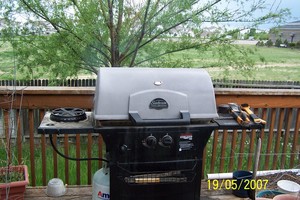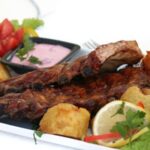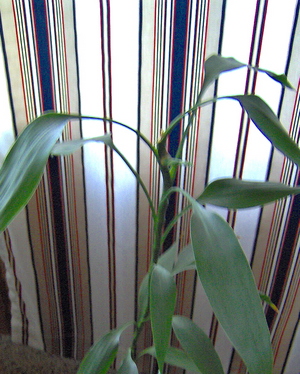What foods can you not cook on a grill? There are none. Not one. You may need special utensils, but you can cook anything on a grill. When my Dad said he was moving to Colorado Springs, I said, “Cool. When I get there, you can come over, and we can grill.” I was planning to move here when I retired from the Navy. He said, “Nah. I’m not big on barbeque.” He had visions of barbeque sauce and chicken no doubt. Unfortunately, he passed away before I got here. If he had lived, he would have learned there is nothing you cannot cook on the grill, and it is not all barbeque. It’s also not only a summer event. There are two times when I will not grill: During a thunderstorm and when the grill is buried under a four-foot snow drift. Otherwise, I have been known to shovel a path from the back door to the grill and stand there with an umbrella in the rain. Don’t laugh. Try it.
You can cook soup, spaghetti, and artichokes. All you need is a pan or pot, and, preferably, an outside burner, though it’s not necessary. If you don’t have one of those, it is wise to have pots and pans without plastic handles. I’ve cooked artichokes when it was really hot (I don’t have air conditioning). If my neighbors saw me, they would look at me funny. I don’t know why. When I was married and stationed in Patuxent River, Maryland, in 1993 (I think), we had a storm…an ICE storm. We lost power for a week. It was the best time in my married life. We had a fireplace for heat. Why we didn’t drag the mattress into the great room is beyond me. We crawled into a freezing bed every night and awoke to a 55-degree house. Could have been worse, I suppose. We had snow and ice to keep things cold. And, we had a gas grill to cook. Had it not been for the fact that we didn’t have cookware without plastic, we could have heated water to wash. Instead, we had to go to the base to shower when it was finally safe to drive. I have cookware without plastic now just for that reason. Now all I need is a fireplace. My point here is that you can cook anything on a grill. Fire can be a wonderful thing. Everyone should have a fireplace, a grill, and cookware without plastic.
There are two ways to grill: Direct and indirect. Both are self-explanatory. Direct is over the heat, indirect is not. I prefer indirect. It is said if you sear meat over direct heat, it seals in the juices. I’ve never done that, and my meat is always juicy. That’s not to say that you can’t do it. Maybe if I did, my meat would be even juicer. My grill has two burners. As long as you have more than one, you can grill with indirect heat. If you use charcoal, just move the charcoal to one side so the food is not directly over the heat.
A popular thing to do is wrap foods in aluminum foil. I use it for potatoes, mushrooms, pepper strips, corn on the cob, and onions, although you can use a rack designed for that purpose (see picture at left). It’s smart to use it for flimsy fish fillets too. There is nothing more annoying than to have something fall through the grate into the fire, lost forever. Grilled vegetables are great. A favorite of mine is acorn squash. Cut it in half, drizzle it with extra virgin olive oil, sprinkle with the herb(s) of your choosing, grill face down for about 10 minutes, turn over, and grill for another 25-30 minutes. Yum.
There are a few points to remember for indirect grilling…for any grilling, for that matter:
1. As with any meal, plan accordingly. Vegetables like corn and potatoes take longer than steaks, especially cooked indirectly, usually in 45-60 minutes, depending on size and quantity.
2. Preheat the grill on both sides. Keep the lid closed. Don’t worry if it starts smoking or even flaming. That’s the crud burning off the grate. If it really bothers you, turn off the burner that’s smoking/flaming, and clean the grate with a wire brush.
3. Oil the grate either with oil on a paper towel or non-stick cooking spray. I use Pam. Remember to turn that side off first.
Prepare your food however you like it. Anything can be marinated, chicken, fish, meat, vegetables. However, simple salt and pepper tastes good, too. Some things to remember:
1. Marinade in any container except copper and aluminum. They will discolor the food and container. I use plastic zip-loc bags. Just throw it away after you’re done marinating.
2. Marinades containing acid such as vinegar, salt, or alcohol food should be marinated no more than four hours. If the marinade does not contain these products, food can be marinated longer, even over 24 hours.
3. Marinades containing citrus, the food should be marinated no more than two hours.
4. The smaller or thinner the cut, the more thorough the marinade will penetrate. Large cuts won’t be marinated deep down even if you poke holes in it. For large cuts of meat, I cut slits, then insert slices of garlic before I put it in the marinade. Leave the garlic in while cooking. I’ve never tried an injector. That might help with large cuts, too.
5. NEVER reuse the marinade unless you boil it a full five minutes. If you want to baste with it, set some aside before putting the meat in.
During cooking:
1. If you plan to use barbeque sauce or any tomato-based sauce, put it on at the end of cooking, otherwise it will burn.
2. Don’t keep checking. Every time you open the lid, you add 15 minutes to the cooking time. It’s okay to turn it midway through cooking. Just don’t open, close, open, close.
3. Don’t use a knife or fork to turn the food. You lose tasty juices. Use tongs instead.
3. Always use a meat thermometer, especially when cooking poultry or pork. These you want to cook well done. An instant-read thermometer works well. I use a battery-operated digital thermometer. The probe stays in the meat. The thermometer beeps when the meat has reached the desired temperature. They’re not expensive and are a good investment. I use the instant-read as backup to make sure the other is accurate, especially with thin cuts. For fish, it’s done when it flakes easy. Some people like some types of fish a little rare, as with salmon. I don’t care for that, but you’re the cook. The correct answer is however you like it. When using a battery-operated digital thermometer, remember to wear a oven mit. It will get hot.
4. I know you’re saying, “She just said not to poke the food.” Well, there’s an exception to every rule. In this case, it’s checking the temperature. Which is why you want it to rest. It absorbs whatever juices have worked themselves out.
After cooking:
1. Let beef and poultry rest about 10 minutes (20 minutes for large cuts) so juices can be absorbed back into the meat. As it rests, it continues to cook. This isn’t necessary for fish. I cook my steaks rare. By the time I’ve gotten everything ready, the meat has rested for about 10 minutes and is then done to perfection.
2. Leave the grill on (turn on the side you cooked on, you can turn off the other side) to burn off excess food. This makes preparation easier the next time you grill.
There is nothing you cannot cook on a grill. Some things you can’t just throw on the fire, but in the end it is always well worth the effort. If Dad had lived, he would have been pleasantly surprised. He would have been a consistent guest at my table.







